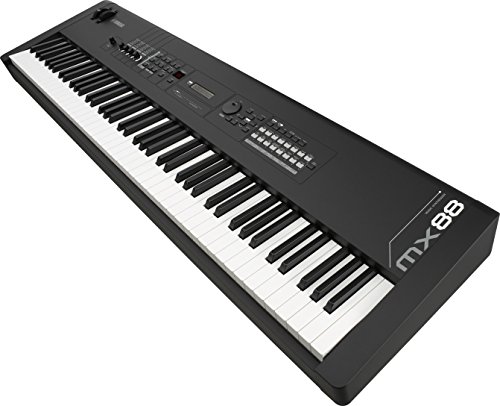

Roland and Yamaha are two of the most respected piano manufacturers in the world, and in this comprehensive review we compare two of their popular models: Roland Juno DS88 vs Yamaha MX88.
Since both models have superb qualities found typically in upscale pianos, many piano enthusiasts have a hard time pointing out which is a better choice. In this article we make that a little easier by comparing features, advantages and disadvantages, and some questions to ask to help you might the right choice for you!
Table of Contents
- Roland Juno DS88 vs Yamaha MX88 Specifications Compared
- Major Similarities Between Roland Juno DS88 VS Yamaha MX88
- Major Differences Between Roland Juno DS88 VS Yamaha MX88
- Roland Juno DS88 Summary
- Yamaha MX88 Summary
- Video: Roland Juno DS88 and Yamaha MX88 Comparison
- Conclusion
Roland Juno DS88 vs Yamaha MX88 Specifications Compared
The table below shows the comparison of Roland Juno DS88 and Yamaha MX88 specs:
Major Similarities Between Roland Juno DS88 VS Yamaha MX88
The major commonality between the Roland Juno DS88 and Yamaha MX88 is they are both synthesizers with 88 number of keys. These are professional instruments for use in the studio or on stage. They are of higher quality than typical keyboards. Plus, they also allow you to alter the sounds of the devices with great precision as you may want. Thus, they are a better choice than keyboards, especially if you want a musical device for your studio or professional practice.
The Roland Juno DS88 and Yamaha MX88 also have a great number of real-time controllers. They also make excellent master keyboards for DAW – Digital Audio Workstations. You can also transfer both audio and MIDI via the built-in USB port of the back panel of the instruments. Both the devices have special reverb and chorus settings that can be played with to get excellent vocal performances.


Major Differences Between Roland Juno DS88 VS Yamaha MX88
On the price front, the Yamaha MX88 is slightly more expensive than the Roland Juno DS88. The former is €22 costlier than the Roland Juno DS88.
While they have the exact number of keys, the devices vary in the types of keys they boast. Juno DS88 features a weighted-action, Roland Ivory Feel-G keyboard while the Yamaha MX88 boasts fully-weighted graded hammer standard keys. The “ivory feel” of Roland Juno means the keys are slightly more textured. Not only do they feel great, but they reduce the chances of your fingers from slipping while playing the piano. When it comes to the sound engine, the Yamaha MX88 has a motif sound engine while Juno DS88 has a specialized Juno engine, which is Juno-Di compatible.
Ronaldo Juno DS88 also weighs heavier (35 lbs.) than the Yamaha MX88, which weighs up to 30.6 lbs. only. The former is shorter in height (5.68”) and wider (55.75”) than its counterpart, which is 6.6” tall and 51.9” wide.
As compared to other piano models from the MX range, the MX88 has a relatively small screen. That said, the screen is wide and clear enough. You can easily navigate through the sounds without any hesitance. On the other hand, Roland DS88 has a big screen on which texts appear in white on a dark blue background. Even though the screen is not massive by today’s pianos’ standards, but it makes the navigation a satisfactory experience.
The Yamaha MX88 also features amazing recording and editing tools. It also offers “HALion Sonic SE” and “Groove Agent SE,” which offer a wide array of terrific instruments, grooves, and electronic drums. That’s not all. It also has a high-end AmpSimulator, which increases the amps of the instrument. On the other hand, Juno DS88 offers none of these or anything like these features.
Roland Juno DS88 Summary

Major Features
|
FEATURE |
DESCRIPTION |
|---|---|
|
Simple Interface and Design |
The Roland Juno DS88 boasts a simple yet effective layout. With no complexities involved, the digital device is easy to navigate. You can easily steer through all its features without any trouble. On top of all, it has a neat, sharp LCD graphic display, which is also easy to operate. The neat design and friendly interface makes the piano a great model for regular practice. |
|
A Wide Library of Sounds |
One of the best features of the Roland Juno DS88 is that it allows free access to a massive library of sound options. Visit the Roland website, and you get the entire Juno sound bank with hundreds of sound samples. With a vast amount of sound effects, the Roland Juno DS88 gives you a lot of scope for creativity. You can experiment with as many music genres as you want and play all sorts of unique piano tones.
The default, built-in effects include reverb, chorus, phaser, delay, and lots more. Some other interesting effects are the pitch shifter and piano reverberation filter. |
|
Portable |
The Roland Juno DS88 makes for a great portable piano. Since its lightweight and has a compact size, it can be carried around in vehicles or on foot. Because of its maximized mobility, this piano model is great for gigs. Not only that, but its portability makes it easy to play around the house, as well. You will just need to connect it to a power source, and you’re good to go. |
|
Excellent Functions and Modes |
The Roland Juno DS88 boasts many functions; the synthesizer has an inbuilt playback function that lets you use typical audio records in a WAV arrangement. This allows you to practice and jam your favorite songs just as you want. Furthermore, the piano allows you to play more than one sound effect with just one key. In this way, you can produce new and exciting music. The most amazing feature of the DS88 is its wireless USB that connecting to your piano is made super easy using an app, letting you connect it with your mobile phone – Android or iPhone. |
Pros and Cons
Pros
- Lightweight and portable
- Velocity-sensitive keys
- User-friendly interface
- MIDI enables you to record and playback your music
- Provide realistic sounds
- Allow you to produce innovative music
- Offer external storage with a USB flash drive
- Diverse sound effects, Auto-Pitch, and Vocoder
- DAW mode available and USB compatibility available
- Feature phrase pads for improved performance
Cons
- The LCD display is too small
- Lacking in the speaker quality
The Bottom Line
The Roland Juno DS88 is known for its manageability. It has a convenient size, which makes it easy and comfortable to move around. Considering this, the digital device is perfect for those performing at gigs or playing in local clubs or pubs. While it is a great option for solo players, it can be used by those playing in a band. Its additional sounds and sound layers help create adequate music for an entire band.
Remember that the Roland Juno DS88 is for serious players. It is not for beginners just starting out to play the piano. It’s designed specifically for professionals or experienced pianists.
Yamaha MX88 Summary

Major Features
|
FEATURE |
DESCRIPTION |
|---|---|
|
Easy to Play |
Owing to the Graded Hammer Standards, the Yamaha MX88 is super easy to play. It’s heavy in the bass range, but as you go up the treble keys, it becomes light and nice to play. All in all, it offers a well-balanced experience to the player. Even if the keys absorb moisture, you won’t face any slipping issue, even for prolonged practice or performance sessions. |
|
Lightweight |
One look at the product and you might think that it is super heavy. However, that’s not the case at all. It is, in fact, lighter than the Roland Juno DS88, so you can imagine how easy it is to transfer this device from one place to another.
You can easily carry or mount it up on a stand – without any help. Unlike many synthesizers, the digital device not only is featherweight but offers a great many features. |
|
Incredible Sound Quality |
The Yamaha MX88 produces great music – there are no two ways about it. The outstanding sound quality is what makes this digital device worth the price. You can play any kind of song you want from its amazing music options and enjoy any music genre from classical to hip hop to rock to lots more.
When playing this instrument, you will have 16 different sounds to pick from. The best part is you can easily move from one sound to another with just a click of a cursor without having you go to the main menu. What’s amazing is, you won’t hear any break offs while switching from one piece of music to another. |
|
Dual Modes and Tones of Features |
The MX88 features two types of modes – layer mode and split mode. The layer mode allows you to play two or more sounds simultaneously. The fascinating bit is the layer mode lets you combine 16 sounds at the same time. On the other hand, the split mode lets you play different sounds (on the left and right side of the instrument) simultaneously.
Other than these modes, the MX88 has hundreds of rhythm patterns that are divided into sections such as rock, R&B, jazz, electronic, world, and orchestral. With this instrument, you also get a USB audio and MIDI interface, DAW control, and an FM synthesizer app for free. |
Pros & Cons
Pros
- Refined fully weighted keys
- Extensive range of songs, rhythms, and effects
- Feature DAW interface and USB audio interface
- Outstanding sound quality
- Include approximately 999 arpeggiator patterns
- Easy to use and accessible functions
- Best for editing, arranging, and manipulating music
Cons
- Lack of a built-in speaker
- A few of the sampled sounds are obsolete
- Lack MIDI sequencer on-board
The Bottom Line
The Yamaha MX88 is distinguished by its massive song library that has all sorts of genres, making it no less than a gem for serious music players. The device is specifically aimed at professional musicians who may as well want a workstation keyboard. The large song library is fit for all sorts of gigs. The instrument also has an editing feature, which makes it a great choice for professional musicians who want to produce innovative music for their audiences. It’s also a touring piano so you can easily carry it around.
Video: Roland Juno DS88 and Yamaha MX88 Comparison
Conclusion
While the Roland Juno DS88 and Yamaha MX88 are somewhat similar, they still vary in many ways – features, pros and cons, and price value. That being said, both digital devices are great for professional pianists or musicians. Because of their size and portability, the Roland Juno DS88 and Yamaha MX88 are both convenient choices!
